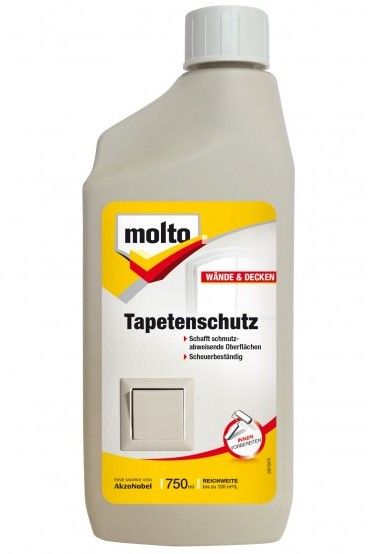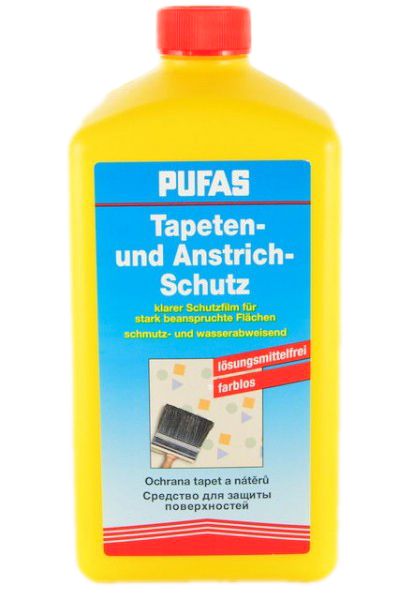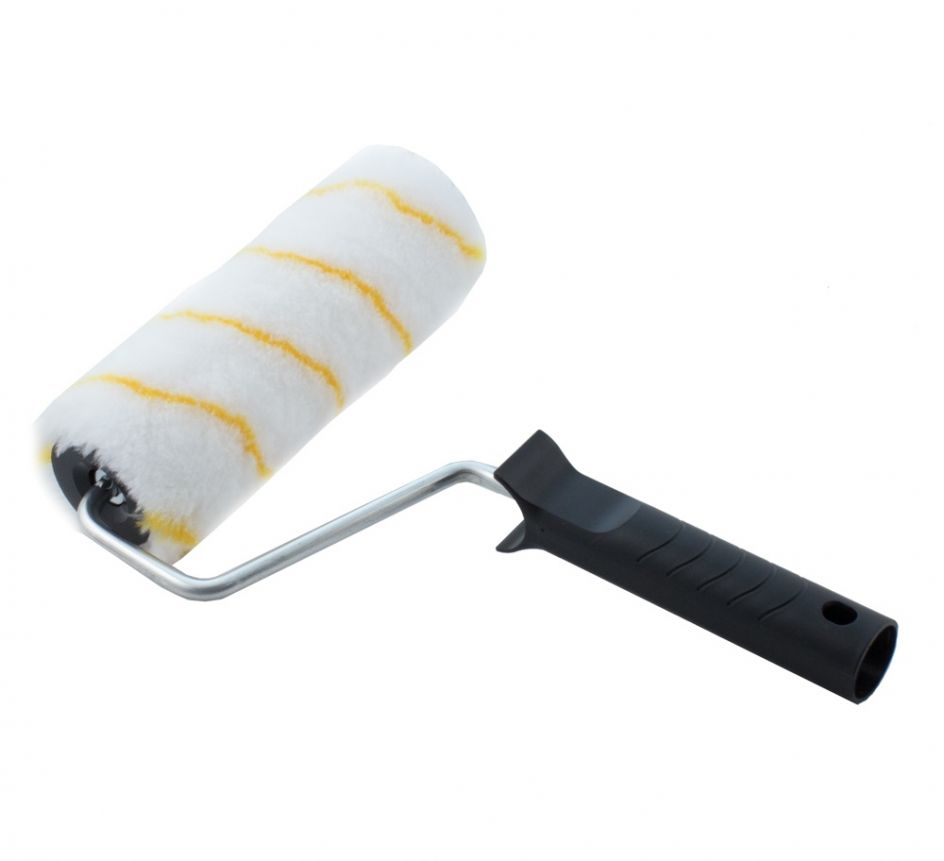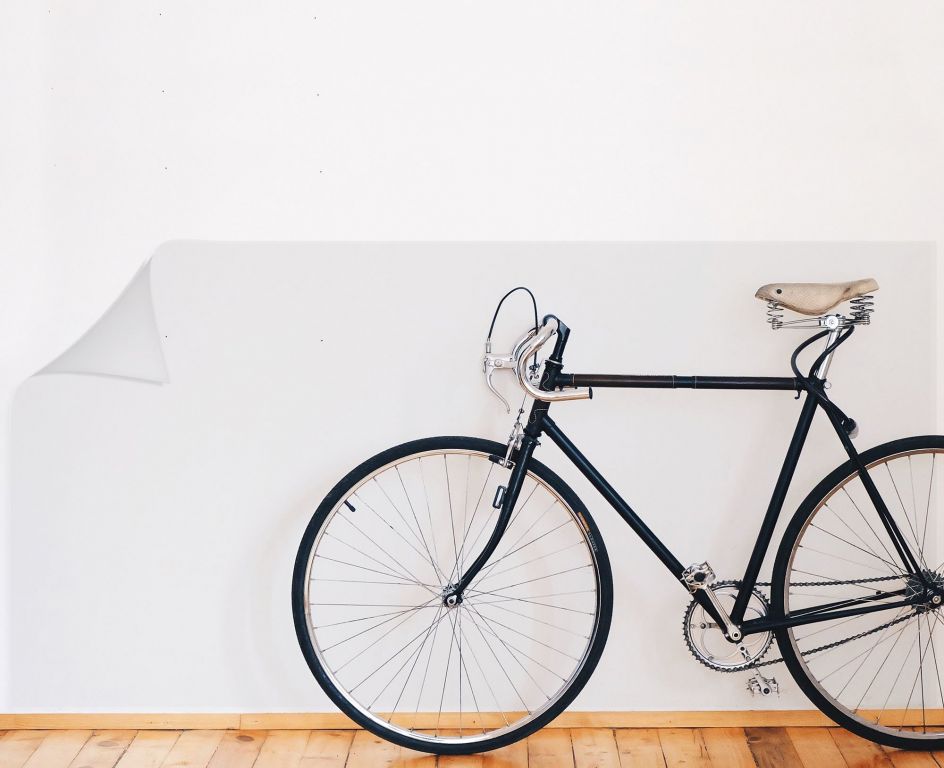Wallpapers with non-washable surfaces can be sealed with a liquid "wallpaper protection fluid" so that they are dirt-repellent and washable. The transparent protective coating is ideal for design and pattern wall décor in rooms that are moderately to heavily used, for instance kitchens, bathrooms, stairways, kids' rooms, or public buildings with large numbers of visitors. Alternatively, transparent wallpaper protection foil is available on the market. This is glued onto the wallpaper.
This guide will explain when and why this kind of coating is appropriate, which wallpaper surfaces and types are suitable, and what details to consider. In addition we will list the differences between liquid, i.e. spreadable products, and transparent foil.
Our step-by-step instructions for the application of the protective fluid will help you coat your favourite wallpaper (if it is suitable). And lastly, we will provide you with useful tips on how to care for your sealed wallpaper and for removing the coating or the wallpaper itself.

Small excursion: Water-, wash- and scrub-resistant wallpapers
In terms of cleaning/care characteristics, there are the following distinctions:
- Water-resistant (up to the time of processing)
- Wash-resistant
- Highly wash-resistant
- Scrub-resistant
- Highly scrub-resistant
The term "water-resistant" stands for the lowest level of cleanability. Water-resistant wallpapers do not come with any surface coating; only the odd splatter of wallpapering paste can be removed from them. In other words: they are not washable. All other classifications, from washable to highly scrub-resistant, imply that they can be cleaned with a damp cloth. The degree to which this is the case, and which types of cleaning materials and detergents can be used, depends on the classification. In our Guide Blog Washable Wallpaper - A clean solution, you can find detailed information regarding the various cleaning classifications.
Sealing with a wallpaper protection fluid or foil is mainly suitable for water-resistant paper-based models or washable non-woven models. Vinyl wallpapers already come with a protective coating and do not require additional sealing.

How to seal non-coated wallpapers
If you find yourself in the situation that you have recently put up new wallpaper but now realise that it might not be robust enough for the specific room, and a certain level of washability and dirt-resistance is required, you might contemplate adding some sort of surface protection. You might have chosen your wallpaper simply because it is exactly to your taste, not taking into consideration whether it has a washable surface - another good reason to think about applying a protective coating. But before you begin the process, a few things need to be considered. Most of the wallpaper protection products available come with the declaration "Suitable for all types of wallpaper", but there are exceptions. After all, wallpaper surfaces are extremely varied and the decision should be based on facts.
When it comes to adding a permanent protective coating, there are two choices: "wallpaper protection fluid" (liquid and transparent), or transparent wall protection foil (in rolls or per running meter). Another - colloquial - term is "elephant skin", inspired by the thick and robust hide of these huge proboscideans.
The liquid form is much easier to apply, which is why laypeople usually prefer it. It has proven to be ideal for wall décor that consists entirely of paper. Applying protective foil requires much more patience, skill and practice, and it is more suitable for smaller areas, e.g. a feature wall, a wallpapered fireplace surround or decorative wallpaper pieces.
Which wallpaper types and surfaces are suitable for protective coating?
Generally speaking, for both types of protective treatment (liquid or foil), the surface needs to be dry, clean, fat-free and stable. In terms of wallpapers, the surface can be structured or embossed, i.e. it doesn't have to be totally smooth, but it needs to fulfil the above criteria.
Design wallpapers with paper or non-woven carriers come with a large variety of surface materials and finishes. These are the determining factor when it comes to deciding whether sealing or coating with liquid or foil wallpaper protection is an option.
Metal and effect foil wallpapers, nature models with surfaces made from cork, grasses, or mica stones, and textile or glass bead wallpapers are all unsuitable for the treatment. Liquid protective products cannot be used for these types of wall décor as they will not adhere to the surfaces mentioned above. The special optical effects of these structures would be sealed in, destroying the character of the design wallpaper. The chemical reactions of surface materials and liquid protection products cannot be predicted, and the process is therefore too risky. In addition, useful characteristics like moisture regulation and breathability, especially with nature wallpapers, would be lost. For the same reasons, using transparent foil as a protective treatment is also not a good idea.
For paper or non-woven wallpapers, a "reaction test" should be conducted first. For paper-based wall décor, this test will identify any sign of discolouration; for non-woven wallpapers it shows if the necessary adherence is present. Liquid wallpaper protection products can simply drip off non-woven wallpaper.
Wash-resistant wallpapers are sometimes treated with wallpaper protection products to achieve a much higher degree of cleanability. However, whether this is an option always depends on the individual wallpaper type. A liquid protective coating is unlikely to achieve the same level if scrub-resistance that most vinyl wallpapers are already equipped with. As for protection foils, the suitability of the wallpaper depends on the degree of adhesion. Thorough cleaning with a brush or sponge is not an option with this variation. In summary: additional coating of washable wallpapers isn't necessarily advisable.

1. Wallpaper protection fluids - products and important information
Liquid wallpaper protection products are often used to seal feature walls or entire wallpapered rooms to protect them from dirt and damage. Once applied, this protective fluid, also known as "elephant skin", wallpaper skin, plastic dispersion or dispersion primer, dries to create a transparent matt or gloss layer. These products are predominantly designed for wallpaper, but they can also be used to make posters, collages, wall paint, interior plaster or trowelling technique washable.
The acrylic-based liquids are solvent-free, water-soluble and non-yellowing. The amount of water used for thinning the liquid determines the eventual degree of shine. The more water is used, the less shiny the surface will be.
Package sizes are chosen depending on the area to be covered. Bottles and canisters between 250 ml and 1000 ml content are available. The colour and consistency of these products is best described as "milky". This is no reason for concern - after the treatment has been applied, it dries and becomes totally clear.
Always store wallpaper protection products in a tightly closed container in a cool, dry, frost-free place. When applying the product, direct sunlight should be avoided. The ideal room temperature is between 15 and 21 degrees Celsius; the fluid should not be used if the temperature is below 10 degrees. Proper ventilation during the process is a must. Depending on individual health-related sensitivities, a breathing mask might be recommendable.
The absorbency and thickness of the protective layer (depending on the expected level of strain) determine the drying time. On average and with sufficient absorbency, this will take about 3 hours. In order to guarantee good protection, two or three layers are usually required. The protective layer can be applied with a brush, roller or ceiling brush. Any tool used should be cleaned under running water immediately afterwards.
The surface needs to be dry, clean, fat-free and absorbent, i.e. any traces of dust, loose particles or other contaminants must be removed beforehand. Open seams or small damages should also be dealt with in advance to achieve perfect results.
Before applying the liquid protective layer, it is recommended that a test should be conducted on a small area out of sight, or preferably on a piece remaining from the wallpapering process. This will give definite results in terms of how/whether the wallpaper absorbs the liquid and whether it is suitable.
Here is a list of some wallpaper protection products (mostly manufactured in Germany but available internationally):
- Molto Tapetenschutz
- Pufas Tapeten- und Anstrichschutz
- Caparol
- Sycofix


It is best to choose a product that is described as "wallpaper protection", "liquid laminate" or "aqueous plastic dispersion solution". Clear varnish is definitely not suitable as a protective coating as it will result in a yellowing, greasy looking film and can react negatively with the wallpaper or even dissolve it.
The cleanability characteristics of the sealed wallpaper depend on the chosen protective product and the number of layers applied. Almost all wallpaper protection products can be washed off with water, household cleaner and a clean cloth. Some of them, for instance Molto wallpaper protection fluid, are even scrubbable and allow for stronger pressure during cleaning, as well as the use of sponges or soft brushes to remove stains.
Removing protective layers will result in damages to the wallpaper. Just as it is the case with paper-carrier design wallpapers that come with a coating, removing wall décor that has been treated with liquid wallpaper protection afterwards requires slightly more effort. The main factor here is whether the surface layer can be removed from the carrier layer, as is the case with those models that do not need soaking before removal. If the bottom layer is intact and clean, it can be wallpapered over; if not, it will have to be soaked and scraped off the wall. Paper-based wallpapers which can only be removed after soaking always have to be pre-treated with a spike roller to penetrate the wallpaper surface and allow moisture in.


Instructions for the application of wallpaper protection fluid
These step-by-step instructions will help you seal your wallpaper and make it dirt-repellent and washable. Always make sure that you are using the right products. As the chemical composition of the content substances differs from manufacturer to manufacturer, it is advisable to always check the product information included in the packaging. The process described below is usually correct for the majority of products:
- Move furniture and decorative items away from the wall in question and cover the floor in plastic sheeting to protect it from splashes. Turn off the electricity if you work on walls with plug points or power supply lines. Remove wall lamps and switches as well as socket frames. Put masking tape over door and window frames as well as skirting boards etc. to protect them.
- Carefully clean the walls with a soft, lint-free dust cloth; alternatively, you can vacuum the wall (especially if the wallpaper is quite robust).
- Move furniture and decorative items away from the wall in question and cover the floor in plastic sheeting to protect it from splashes. Turn off the electricity if you work on walls with plug points or power supply lines. Remove wall lamps and switches as well as socket frames. Put masking tape over door and window frames as well as skirting boards etc. to protect them.
- Carefully clean the walls with a soft, lint-free dust cloth; alternatively, you can vacuum the wall (especially if the wallpaper is quite robust).
- Use a clean bucket to mix the protective liquid with water, according to the information on the packaging and the desired level of gloss. Example: If you prefer the matt variant, the dilution ratio for many products is 1:4. This means one part protection fluid to 4 parts water.
- Dip your brush, ceiling brush or roller into the prepared liquid, making sure that the tool is covered evenly. Wipe off any excess fluid on the bucket edge.
- Now start applying it away from the light. Always begin with corners and recesses. Work from top to bottom and left to right, i.e. crosswise, to achieve an even appearance. This way the protective fluid is spread evenly and thinly. The layers need to be thin to make sure that they dry clear. If they are too thick, they look milky.
- One single layer is usually insufficient. The desired strength of the protective skin as well as appropriate resistance to dirt and moisture can only be achieved with more than one thin layer. It is a question of trial-and-error - you will make your own decision as to when the required layer strength has been reached.
- After each layer has been applied, it has to fully dry before another one can be added. Once this has been established by carefully wiping over it with a hand or finger, the process can continue.
- Make sure you wash your tools under running water and dry them after each layer.
- If there is still some liquid in the bucket after you have finished, please do not pour it in the toilet or sink. Fill the remaining liquid into a suitable container, close it tightly, label it and take it to the recycling/disposal centre.
- Any remaining liquid still in the bottle or canister can be stored in a cool place away from sunlight. If they are not needed any longer, take them to the appropriate recycling or disposal facility.
2. Wallpaper protection foil
Self-adhesive wallpaper protection foils are available in a large number of widths and strengths, transparent matt or gloss, in rolls or as running meters. Standard widths are 60, 100, 120, 140 cm, but XXL formats of up to 200 cm width can also be sourced. The thickness of the foil for low-level strain is about 0.07 mm. For walls that are subject to more strain, the thickness should be around 0.170 mm; this type of foil is usually transparent matt. The adhesive used by most manufacturers is solvent acrylate.

For kitchen splash guards, there are special protective foils with heat resistances up to 80 degrees which are also steam-resistant (so will not come off the wall!).
Application of wallpaper protection foils
Depending on the area to be covered, the preferred type of foil is either per running meter or roll. If the width is in excess of 100 cm, a second person should be present during the process.
The foil comes covered with masking paper on both sides. Before you begin, thoroughly clean the wallpaper and remove all traces of dust or other particles. Hands should be clean and dry. Once the foil has been cut to the desired dimensions, the masking paper is removed from the adhesive side and the foil is positioned on the wall. The masking paper should remain on the front for this step. Advanced practitioners now continue by carefully smoothing the foil from the middle towards all directions to remove any air bubbles. Alternatively, special tools can be used to smooth out the foil and make sure it adheres to the wall evenly. Use a liner and a cutter knife to remove excess foil around door and window frames, skirting boards, light fittings etc. Finally, remove the masking paper.
Cleaning wallpaper protection foils
Depending on the thickness of the foil, it can be wiped with a damp cloth and some washing-up liquid or soap. Always use a soft cloth - no sponges or brushes as they leave behind scratches and streaks.
Removing wallpaper protection foils
Some manufacturers promise that the protective foil can be removed from wallpapers without a trace. This claim is somewhat dubious, especially as most producers limit this ability to two years after application.

